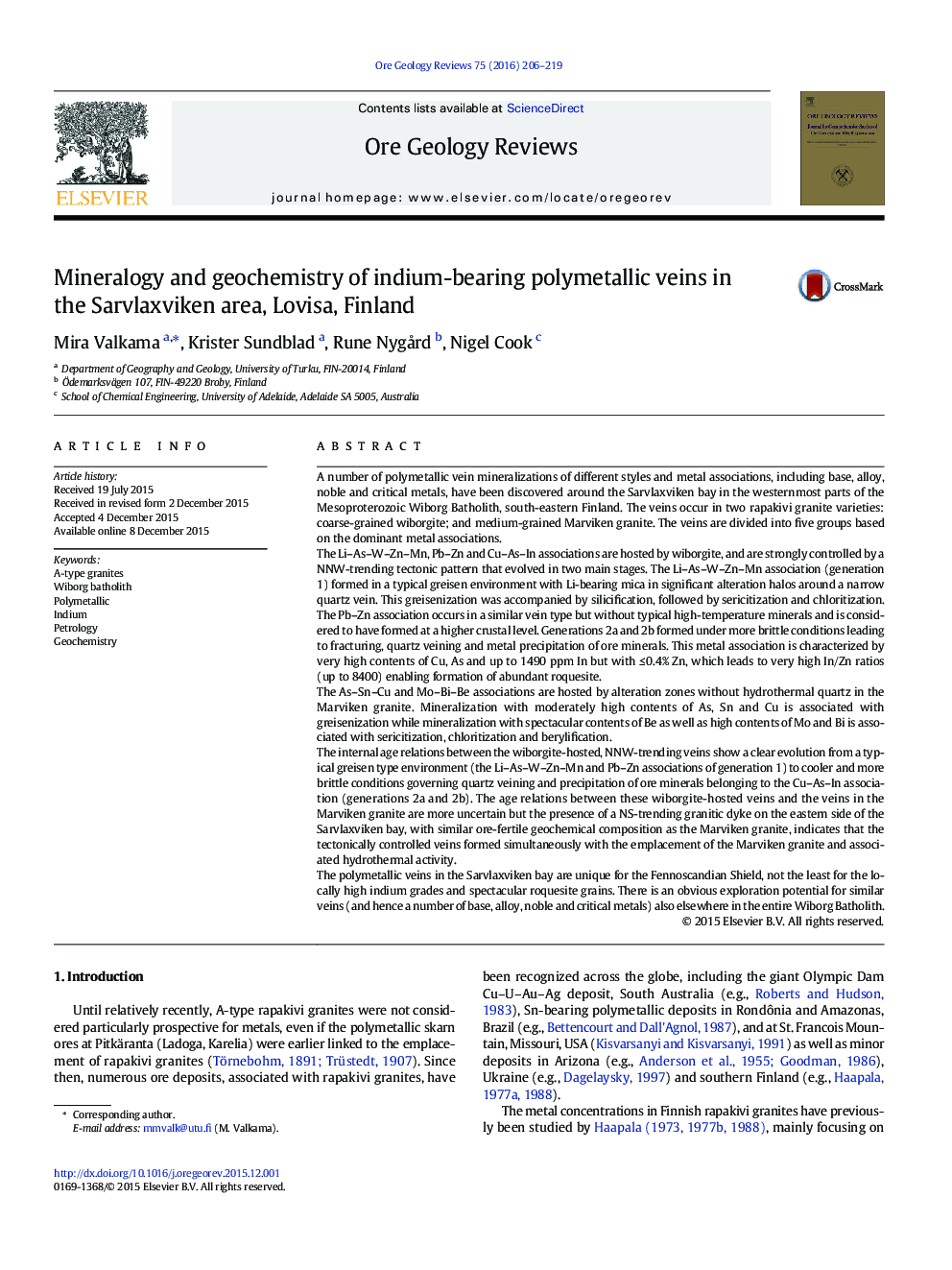| کد مقاله | کد نشریه | سال انتشار | مقاله انگلیسی | نسخه تمام متن |
|---|---|---|---|---|
| 4696902 | 1637231 | 2016 | 14 صفحه PDF | دانلود رایگان |
• Polymetallic veins at Sarvlaxviken carry significant Indium, making them attractive exploration targets given current supply/ demand issues.
• Five metal associations are recognized in polymetallic veins at Sarvlaxviken: Li-As-W-Zn-Mn; Pb-Zn; Cu-As-In; As-Sn-Cu; and Mo-Bi-Be.
• Li-As-W-Zn-Mn, Pb-Zn and Cu-As-In associations are hosted by wiborgite and strongly controlled by NNW-trending tectonics that evolved in two main stages. As-Sn-Cu and Mo-Bi-Be associations are hosted by alteration zones without hydrothermal quartz in the Marviken granite.
• Indium is especially enriched in the Cu-As-In association of polymetallic veins of Sarvlaxviken. A high In/Zn ratio facilitates formation of roquesite.
• Mineralization with moderately high contents of As, Sn and Cu is associated with greisenization while mineralization with spectacular contents of Be as well as high contents of Mo and Bi is associated with sericitization, chloritization and berylification.
A number of polymetallic vein mineralizations of different styles and metal associations, including base, alloy, noble and critical metals, have been discovered around the Sarvlaxviken bay in the westernmost parts of the Mesoproterozoic Wiborg Batholith, south-eastern Finland. The veins occur in two rapakivi granite varieties: coarse-grained wiborgite; and medium-grained Marviken granite. The veins are divided into five groups based on the dominant metal associations.The Li–As–W–Zn–Mn, Pb–Zn and Cu–As–In associations are hosted by wiborgite, and are strongly controlled by a NNW-trending tectonic pattern that evolved in two main stages. The Li–As–W–Zn–Mn association (generation 1) formed in a typical greisen environment with Li-bearing mica in significant alteration halos around a narrow quartz vein. This greisenization was accompanied by silicification, followed by sericitization and chloritization. The Pb–Zn association occurs in a similar vein type but without typical high-temperature minerals and is considered to have formed at a higher crustal level. Generations 2a and 2b formed under more brittle conditions leading to fracturing, quartz veining and metal precipitation of ore minerals. This metal association is characterized by very high contents of Cu, As and up to 1490 ppm In but with ≤ 0.4% Zn, which leads to very high In/Zn ratios (up to 8400) enabling formation of abundant roquesite.The As–Sn–Cu and Mo–Bi–Be associations are hosted by alteration zones without hydrothermal quartz in the Marviken granite. Mineralization with moderately high contents of As, Sn and Cu is associated with greisenization while mineralization with spectacular contents of Be as well as high contents of Mo and Bi is associated with sericitization, chloritization and berylification.The internal age relations between the wiborgite-hosted, NNW-trending veins show a clear evolution from a typical greisen type environment (the Li–As–W–Zn–Mn and Pb–Zn associations of generation 1) to cooler and more brittle conditions governing quartz veining and precipitation of ore minerals belonging to the Cu–As–In association (generations 2a and 2b). The age relations between these wiborgite-hosted veins and the veins in the Marviken granite are more uncertain but the presence of a NS-trending granitic dyke on the eastern side of the Sarvlaxviken bay, with similar ore-fertile geochemical composition as the Marviken granite, indicates that the tectonically controlled veins formed simultaneously with the emplacement of the Marviken granite and associated hydrothermal activity.The polymetallic veins in the Sarvlaxviken bay are unique for the Fennoscandian Shield, not the least for the locally high indium grades and spectacular roquesite grains. There is an obvious exploration potential for similar veins (and hence a number of base, alloy, noble and critical metals) also elsewhere in the entire Wiborg Batholith.
Figure optionsDownload as PowerPoint slide
Journal: Ore Geology Reviews - Volume 75, June 2016, Pages 206–219
